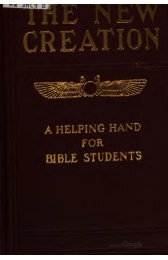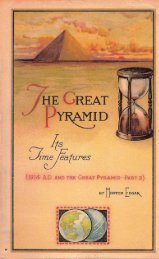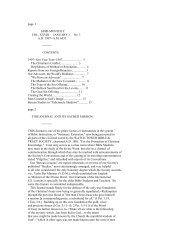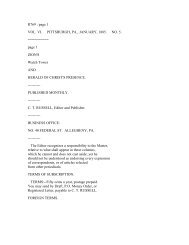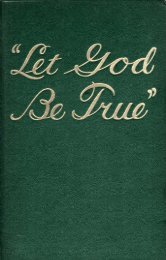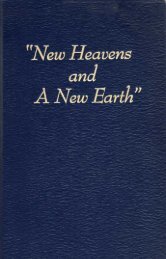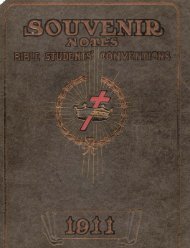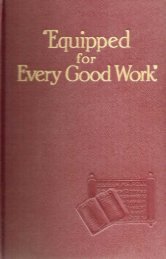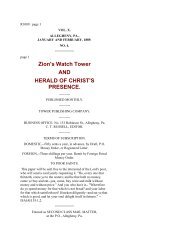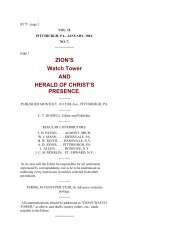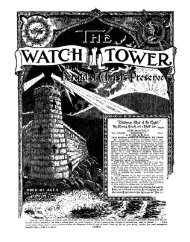The Watchtower Society and John and Morton Edgar - A2Z.org
The Watchtower Society and John and Morton Edgar - A2Z.org
The Watchtower Society and John and Morton Edgar - A2Z.org
- No tags were found...
Create successful ePaper yourself
Turn your PDF publications into a flip-book with our unique Google optimized e-Paper software.
.__..-..._I--.-.--<strong>The</strong> Golden Age.........-.....-.-.........-....---..-.--.-...--..~vhich-oux-QnJ desua <strong>and</strong>. many of the earlyChristians wq$# dane to death, is cdlecl o restred dmgmngat,qery serpeut". (See Diaglott,+nd compare with verse 9) Papsauins informsua that "the dragon with the Greeks was only alarge snake". (Lib.11, Corinthiclca, cap. 23, p. 175)Sir Ita~ Lanlcester proves that the conventional"dragon" with wings. dreadfd claws, etc., is alater imagirihry repre~el~tation, mld is not thedragon as knomm ill the ancient world. Hemi t ~ : s-p <strong>The</strong> dragon appilred to be nothing more nor lesin its origin tho11 one of the great snakw (pythons),often tm-em>-fire feet in lt~~gth. which inhul,it tropicalIndia <strong>and</strong> -1-fricn. It3 tlilngerous character <strong>and</strong> terribleappearance ;:xd inov~rnent impreqwl prinlitive mankind.an(1 triitlitiu~~s of it have passed with nlipratingraces both to the FAA <strong>and</strong> to the \Vest. so that we findthe m~tliical dragon in nl~cient Chinir <strong>and</strong> Japan, noIesn than in Egypt <strong>and</strong> Gr-. It retains its snake-likebod^ am1 fa$, especially in the Chinese <strong>and</strong> Japanesereprewntations; but in both East <strong>and</strong> n'est. Iegs <strong>and</strong>wings Iuw-e been gradually added to it for the p n vIshtar appears to !n? clearlv identified in the list of the'great gads of -4ssvrirr. TIicre is nl) reason to hubt thatth5 Isrrriac goddess is the ;\.~!ltorcth [or Isktarorhlof the Old Tesrarlcnt <strong>and</strong> thc .\.+tnrte OE rhc Grqeks ~ i c lRomnno. . . .Tt i~ cvttnin tknt the c-orship of .%&.rtebwaze irtc.r:t:?c~l with that of Vcnus [or Xphroctita]."La-ar~l statits that in the Syiarl temple oflIiern~~!lis. .\.;tal.te "was represented st<strong>and</strong>ing-on a lion, crowned with towers". (Nilrcveh a d -its Remains, Td. IT, p. 456) <strong>The</strong> name Astartoitself means "the wonian that made towers,"being composed of two aor& :.'-Xeht-tart". Ashtis the word for. wonran; <strong>and</strong> it is generallyagreed that the last syllable "tart" comes fromthe Hebrew verb "W which means both "to goronnd" <strong>and</strong> "to be round". From this is-derivedthe Greek \\-ord "tarit", <strong>and</strong> its Engliah equivalent"turret". a ronnd tower. Asht-tnrit, therefore,which is the same as "Ashtoreth" of theHebrew, is literall?. "the woman that made thetower" or e~conbpcrssilig wall. Ovid inentiohsthat. SemirainiP was currently believed to have"sru-ronnd~l Babylon with a wall of brick".(@id, Opcru, vol. IJX; Fa&, IV, 2192221) Bntthere is no new1 ta give dl the e+tof buildingthe battlemeilts of Babylon to Serrrira-ih. <strong>The</strong>reason why elle gained the-honor of fortifyingthe city was becanse she in the long run hadbecome foremost in the esteem of the ancientidolators, <strong>and</strong> thus had attributed to her everyvirtue arid characteristic that properly be-of n1nh3ng it more terrible <strong>and</strong> e-xpressing some of itsdireful q~~nlities. .. . As a matter of fact, the Greek longed, or was imagined to ha~e belonged, tavord 'drakon' actually meant plainly <strong>and</strong> simplp a krge her son Sinus., slake: <strong>and</strong> is so used bp Bristotle aud other n-ritonJ3-Science from an Easy Chair, Serics I, pp. 88, 89.Semiramis was also worshiped as Rhea orCrbele, the '%other of the godd' (Paschal,Sr~itir-nnris Worshiped !older T'ariotrs V nines Clirolzicle, Vol. I, p. 65),3nd as suoh is alwaysJnst as Simrocl was regnrdecl as the sun, <strong>and</strong> represented as wearing a mral -or turreted\\-as given the title Baal, or "lord of heaven" crom on her head. In this respect the Ephesian( for the n-orcl Baal means lord) ,. so Seniiramis, Diana exactly resembled Rhea; for' Diana was\\-hen .she n-as lilie\~Le "(Seified," received wor- dso a tower-bearing ,pldeas, <strong>and</strong> is so shamship as the ~OOII, the "clueen of heaven". SON-, ill ma:ip of the illustrated "Bible Eelpg7. Xow,nccnrtlir~g to -4tlieliagorns nrld Lucinn, Selnir- tlie Ephesian Dinna is espresslp identified withalni..; ~rns \\-o~-sllipt?rl as --Istarte, tire ;?>-ria11 Senliramis; for Semiramis is the same aa thegotlcl~ss. (I,c*fj(ttio. Yol.11. 1,. 1TS:'De Dca S!jrin, goddess Arte~uis. <strong>and</strong> it is well known that Ar-Yol. 111. 11. :X2) This Syria11 gocldess \$-as also tc111is \\-as Dinna. (Layard, Ninezieh <strong>and</strong> itsIcnown as Islitnr (T,a>-nrcl's Siile.ceh aid Baby- Remai~rs, Vol.11. p. m, note) <strong>The</strong> Roman Dianaloit, p.629) : <strong>and</strong> it is froln Ishtar that the \vurd \\-=as a huntress hearing a qnirer of arrows. InEaster is tlcri~ecl. (See 1912 TT'ntch Tower, p.lii) Smith's Bible Dicti~ilnry under tlie article",ishtoreth" says :"From the mn~ction of this porldeao ,with Baal orBe1 re skcid~l ncltnrally conclt~cle that she xould befound i~ the -iss>rinn 13ant.l~eon. nrtd in hct the namethis character she was the complement of Yirodthe "nliglity hunter".<strong>The</strong> universd adoration of the "deified"Semiraiilis under vclrio1t.s Jrnmes nltd titles byEastern nations, is prnmincntly clrann to ourattention in Acts 19: 23-41. "C;rclat is Diana ofthe? l??hesinns." the 1nu1titutIc shouted, "whom:dl- -\silt am\ tlie work1 I\--orshipeth." It is aroiat~~-k:.!~le fi~~t that this great gc~cldess is evenno\\. ~\-nrslliprd ill onr wry 11iicl9t in the personor' the Papal "queen of the hearen", the socalledTirginJIal-p,mhose irnage is set np ererywhere!,I fa\-orite imase of the Ro~nieh Virgin



